外研版(2019) 必修第一册Unit 6 At one with nature Understanding ideas 课件-(17张ppt)
文档属性
| 名称 | 外研版(2019) 必修第一册Unit 6 At one with nature Understanding ideas 课件-(17张ppt) |  | |
| 格式 | pptx | ||
| 文件大小 | 47.8MB | ||
| 资源类型 | 教案 | ||
| 版本资源 | 外研版(2019) | ||
| 科目 | 英语 | ||
| 更新时间 | 2022-12-05 14:09:41 | ||
图片预览

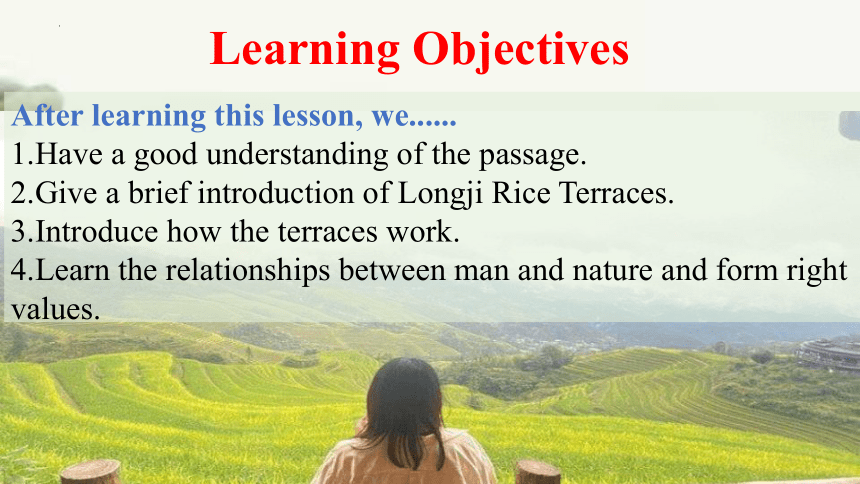
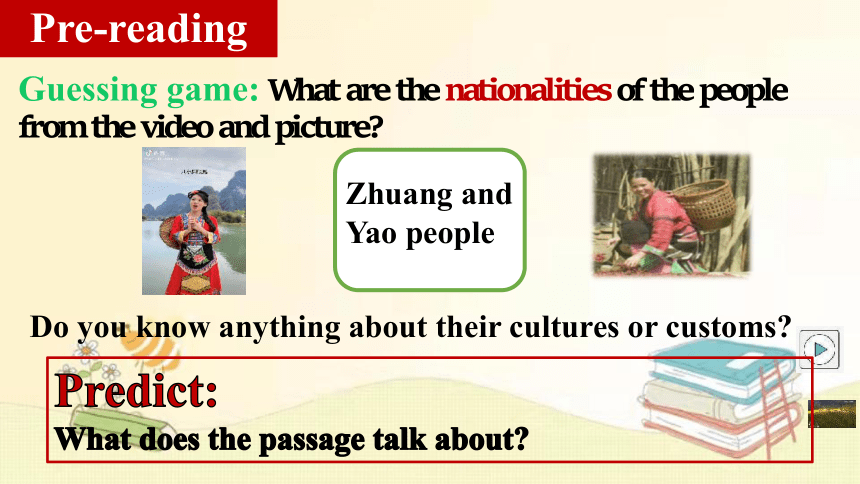
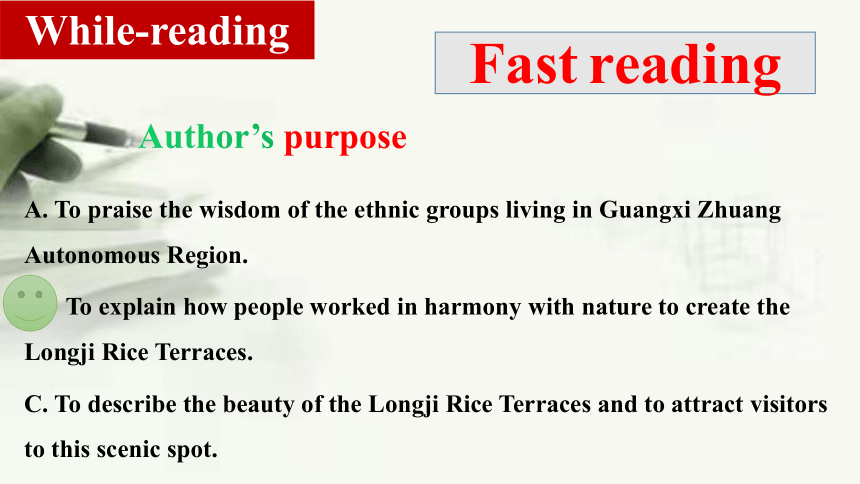
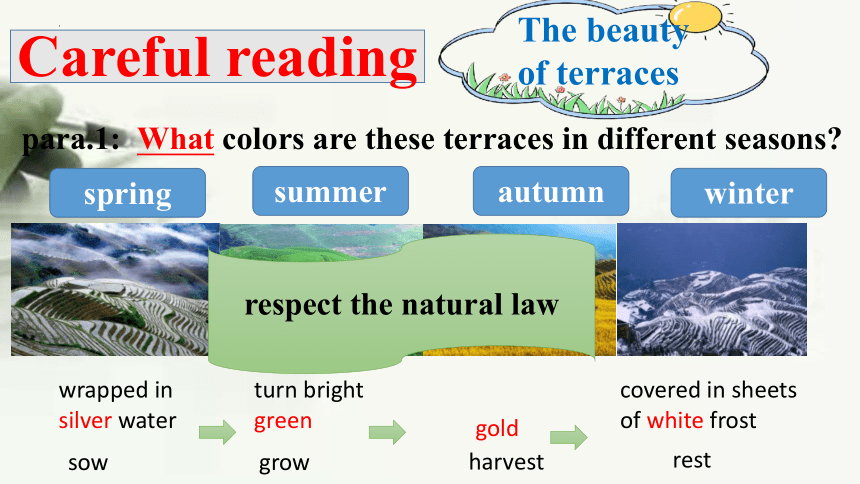
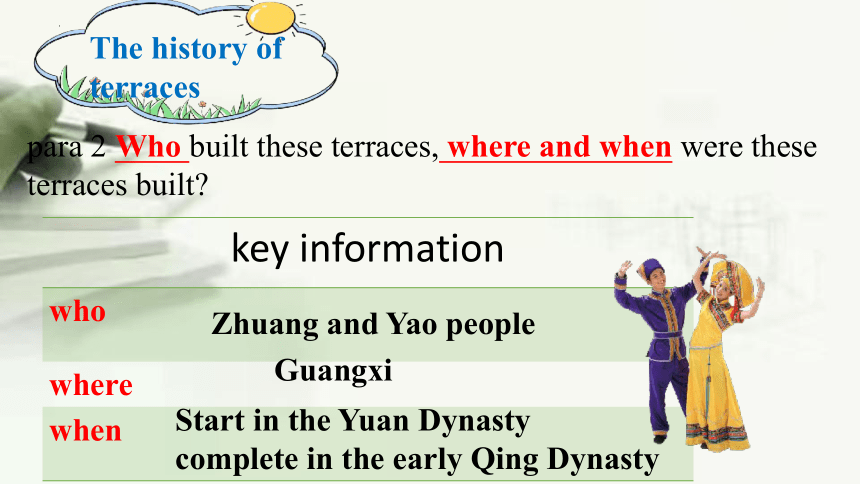
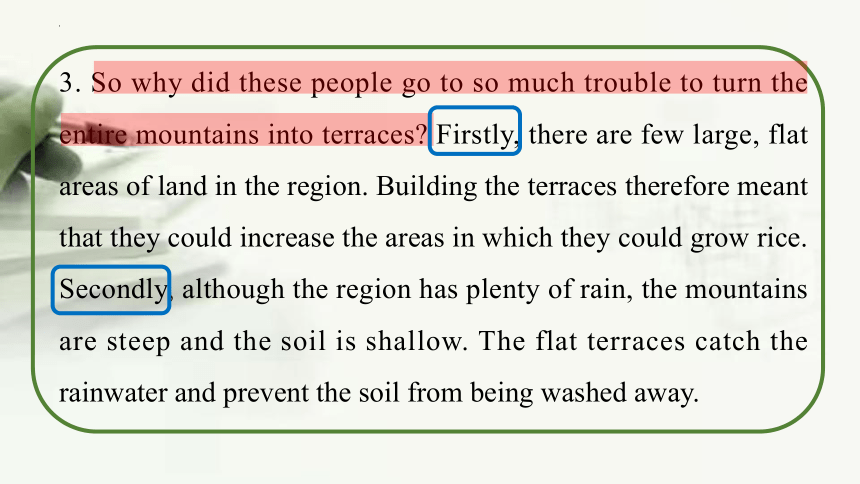
文档简介
(共17张PPT)
BOOK ONE
Unit 6 At One With Nature
Longji Rice Terraces
Learning Objectives
After learning this lesson, we......
1.Have a good understanding of the passage.
2.Give a brief introduction of Longji Rice Terraces.
3.Introduce how the terraces work.
4.Learn the relationships between man and nature and form right values.
Do you know anything about their cultures or customs
Guessing game: What are the nationalities of the people from the video and picture
Zhuang and Yao people
Predict:
What does the passage talk about
Pre-reading
A. To praise the wisdom of the ethnic groups living in Guangxi Zhuang Autonomous Region.
B. To explain how people worked in harmony with nature to create the Longji Rice Terraces.
C. To describe the beauty of the Longji Rice Terraces and to attract visitors to this scenic spot.
Fast reading
Author’s purpose
While-reading
para.1: What colors are these terraces in different seasons
wrapped in
silver water
turn bright
green
gold
covered in sheets
of white frost
sow
grow
harvest
rest
respect the natural law
winter
spring
summer
autumn
The beauty of terraces
Careful reading
para 2 Who built these terraces, where and when were these terraces built
key information who
where
when
Zhuang and Yao people
Guangxi
Start in the Yuan Dynasty
complete in the early Qing Dynasty
The history of terraces
3. So why did these people go to so much trouble to turn the entire mountains into terraces Firstly, there are few large, flat areas of land in the region. Building the terraces therefore meant that they could increase the areas in which they could grow rice. Secondly, although the region has plenty of rain, the mountains are steep and the soil is shallow. The flat terraces catch the rainwater and prevent the soil from being washed away.
A. The vapour forms clouds.
B. The sun heats the water.
C. The rain moves down onto the mountain terraces again.
D. Rainwater moves down the mountains and into the terraces.
E. The water turns into vapour.
F. The clouds form rain.
Para.4 Put the steps into correct order
1
4
2
3
5
6
The working principle
problem solution
_______ large and flat areas in the region _________ the areas where they could grow rice
_________ mountains ________ rainwater
________ soil _______ the soil from being _______ ________
few
increase
steep
catch
shallow
prevent
washed
away
Read para 3 and
fill in the form
The reason to build
3
heat
vapour
clouds
rainwater
waterways
Describe
in harmony with nature
provide perfect environment
The working principle
During the rainy season, ...and... then ...
The value and attraction of the terraces.
value
just grow rice
in the past
at present
a great wonder
attractive attraction
harmony with nature
Match the main
ideas with
each paragraph
Para 1 The reasons to build.
Para 2 The working principles(原则) of the terraces.
Para 3 The beauty of the terraces.
Para 4 The value and attraction of the terraces.
Para 5 The history of the terraces.
natural or man-made
At one with nature
天人合一
Global important Agricultural Heritage
a valuable treasure
Think and share
What should we do to promote the local economy or sustainable development
Useful expressions:
1.The government .../The local people ...
2.We’d better…
3.Don’t.../Avoid
To the government
1.Increase the fund
2.Encourage the local people to grow rice
3.Take some measures to boost consumption
4.Make laws to protect the terraces
To the local people
1.Raise the awareness of protecting the environment
2.Deveolp some local specialties
3.Respect nature and change it properly
4.Promote local culture
Post-reading
Respect nature
Conform to nature
Protect nature
Lucid waters and lush mountains are invaluable assets.
Clear waters and green mountains are as valuable as mountains of gold and silver.
Give an introduction to foreign visitors about Longji Rice Terraces (no more than 100 words)
Homework
BOOK ONE
Unit 6 At One With Nature
Longji Rice Terraces
Learning Objectives
After learning this lesson, we......
1.Have a good understanding of the passage.
2.Give a brief introduction of Longji Rice Terraces.
3.Introduce how the terraces work.
4.Learn the relationships between man and nature and form right values.
Do you know anything about their cultures or customs
Guessing game: What are the nationalities of the people from the video and picture
Zhuang and Yao people
Predict:
What does the passage talk about
Pre-reading
A. To praise the wisdom of the ethnic groups living in Guangxi Zhuang Autonomous Region.
B. To explain how people worked in harmony with nature to create the Longji Rice Terraces.
C. To describe the beauty of the Longji Rice Terraces and to attract visitors to this scenic spot.
Fast reading
Author’s purpose
While-reading
para.1: What colors are these terraces in different seasons
wrapped in
silver water
turn bright
green
gold
covered in sheets
of white frost
sow
grow
harvest
rest
respect the natural law
winter
spring
summer
autumn
The beauty of terraces
Careful reading
para 2 Who built these terraces, where and when were these terraces built
key information who
where
when
Zhuang and Yao people
Guangxi
Start in the Yuan Dynasty
complete in the early Qing Dynasty
The history of terraces
3. So why did these people go to so much trouble to turn the entire mountains into terraces Firstly, there are few large, flat areas of land in the region. Building the terraces therefore meant that they could increase the areas in which they could grow rice. Secondly, although the region has plenty of rain, the mountains are steep and the soil is shallow. The flat terraces catch the rainwater and prevent the soil from being washed away.
A. The vapour forms clouds.
B. The sun heats the water.
C. The rain moves down onto the mountain terraces again.
D. Rainwater moves down the mountains and into the terraces.
E. The water turns into vapour.
F. The clouds form rain.
Para.4 Put the steps into correct order
1
4
2
3
5
6
The working principle
problem solution
_______ large and flat areas in the region _________ the areas where they could grow rice
_________ mountains ________ rainwater
________ soil _______ the soil from being _______ ________
few
increase
steep
catch
shallow
prevent
washed
away
Read para 3 and
fill in the form
The reason to build
3
heat
vapour
clouds
rainwater
waterways
Describe
in harmony with nature
provide perfect environment
The working principle
During the rainy season, ...and... then ...
The value and attraction of the terraces.
value
just grow rice
in the past
at present
a great wonder
attractive attraction
harmony with nature
Match the main
ideas with
each paragraph
Para 1 The reasons to build.
Para 2 The working principles(原则) of the terraces.
Para 3 The beauty of the terraces.
Para 4 The value and attraction of the terraces.
Para 5 The history of the terraces.
natural or man-made
At one with nature
天人合一
Global important Agricultural Heritage
a valuable treasure
Think and share
What should we do to promote the local economy or sustainable development
Useful expressions:
1.The government .../The local people ...
2.We’d better…
3.Don’t.../Avoid
To the government
1.Increase the fund
2.Encourage the local people to grow rice
3.Take some measures to boost consumption
4.Make laws to protect the terraces
To the local people
1.Raise the awareness of protecting the environment
2.Deveolp some local specialties
3.Respect nature and change it properly
4.Promote local culture
Post-reading
Respect nature
Conform to nature
Protect nature
Lucid waters and lush mountains are invaluable assets.
Clear waters and green mountains are as valuable as mountains of gold and silver.
Give an introduction to foreign visitors about Longji Rice Terraces (no more than 100 words)
Homework
